University College London, Institute of Archaeology 31-34 Gordon Square, Bloomsbury, London WC1H 0PY. Email: cara.hirst.13@ucl.ac.uk
Cite this as: Hirst, C.S. 2018 HHARP: The Historical Hospital Admission Records Project – a review, Internet Archaeology 47. https://doi.org/10.11141/ia.47.6
The HHARP database, Kingston University. Available from http://www.hharp.org
Hospital records have frequently been used in epidemiological research (Kilgore et al. 2017; Rushton 2016), and in some cases palaeopathological research. However, the availability of data is problematic, with written records requiring considerable time to interpret, digitise and analyse. In 2001, the Historical Hospital Records Project (HHARP) began digitising over 140,000 hospital admission records from four hospitals in London and Glasgow, providing researchers with an online data base of hospital records (Figure 1). I review the data available in the HHARP database, as well as make a preliminary analysis of the hospital records from London and Glasgow between c.1852-1921 which illustrates the value of the HHARP database in understanding disease and medical care during this period.
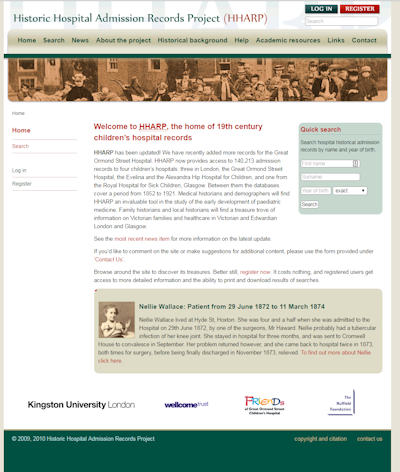
Palaeopathological analysis is limited by both the nature of archaeological material, and the limited skeletal response to pathological stimuli (Dastugue 1980; Waldron 2008; Wood et al. 1992). Historical medical records may be included in palaeopathological research, providing a large case study from which disease and mortality in the past may be investigated, and compared with skeletal lesions (Mitchell 2016). Such comparisons may provide support for palaeopathological analysis, or may reveal discrepancies between the prevalent pathological lesions and historical records (Mitchell 2016; Van der Merwe and Steyn 2010); Magalhães et al. 2017; Santos 2015). Cases where the appearance or prevalence of palaeopathological lesions are not consistent with historical records, have provided valuable insight regarding the social context of disease and injury in past populations (Brickley 2002; Grauer 2016; Mitchell 2011).
As with palaeopathological evidence, hospital admissions are influenced by a number of additional factors, and as such are not truly representative of the general population. For instance, healthcare-seeking behaviours are influenced by a number of social, cultural and economic factors (Andersen 1995), and it has been argued that the decision to seek medical care in a hospital involved a wide range of factors (Berkanovic et al. 1981; Ginsburg et al. 1997). For instance, in 19th and 20th century London, hospital admissions are suggested to have been influenced by available transportation, hospital location, ability to acquire a governor’s guarantee and possible loss of wages: all of which had to be weighed against the potential of home care options (Mant and Holland 2016). Moreover, it should not be assumed that a diagnosis in historical hospital records is consistent with a modern biological diagnosis, as terms change over time, diagnosis criteria evolve, and methods vary (Grauer 2016; Melton et al. 1983; Mitchell 2016; Rogler 1997). Additionally, there are social factors affecting the original diagnosis which need to be considered, such as the socio-cultural consequences of assigning a diagnostic label which may vary depending on the background of the patient or the individual assigning the diagnosis (Grauer 2016). As such, while there are limitations, historic hospital records can be used to provide a greater understanding of the social consequences of disease over time, especially when combined with palaeopathological analysis (Grauer 2016).
The Historic Hospital Admission Records Project (HHARP) began in 2001 as a collaboration between Kingston University’s Centre for Historical Records and the medical archives from children’s hospitals in London and Glasgow. Later in 2015, the database was extended, and at present includes the medical records from Great Ormond Street Hospital (GOSH), the Evelina Hospital (EH), Alexandra Hospital for Children with Hip Disease, Cromwell House (CH) and the Royal Hospital for Sick Children in Glasgow (GLA). In total these records cover a period ranging from 1852 until 1921. The aim of this project was to allow meaningful comparisons between the hospitals and as such each hospital’s register shares common core information, detailed in Table 1 (HHARP).
| Record | Description |
|---|---|
| Patients Name | First name and surname |
| Patient Information | This includes sex and age - provided in years and months and birth year |
| Patient Address | This included street address, county, registration district and sub district |
| Admission Details | This is provided in three columns including length of stay, date of admission & date of discharge |
| Diagnosis | This included standard diagnosis & disease group which has been corrected for variations in spelling and terminology, and original disease and disease group recorded directly form the register |
| Outcome | There are four different outcome options: cured, relieved, not relieved or died |
Some of the hospitals included in HHARP provided additional data in their records which were included in the database. For instance, Cromwell House recorded vaccination status and the patient’s history of infantile disease. Alexandra Hip Hospital detailed further information concerning the nature of hip disease suffered, including deformities and duration of symptoms prior to admission. The Royal Hospital for Sick Children, Glasgow provided further information concerning the patient’s parents, such as occupation and religion. The Evelina Hospital provided details of treatment and in some cases post-mortem results. Unfortunately, data from the Alexandra Hip Hospital could not be included in this comparison due to technical issues with the HHARP database preventing the download of medical records from Alexandra Hip Hospital. The different information provided by each hospital with the exclusion of the Alexandra Hip Hospital is illustrated in Table 2 (HHARP).
| Data | GOSH | EH | CH | GLA |
|---|---|---|---|---|
| Infantile disease history | - | 0.19% | 25.5% | - |
| Smallpox vaccination | - | - | 6.6% | - |
| Discharged to | 66.5% | 6.1% | 33.9% | - |
| Remarks | 32.4% | 13.6% | 76.9% | 9.1% |
| Parent Occupation | - | 1.29% | - | - |
| Post mortem | - | 9.11% | - | - |
| Outcome | 97% | 89.8% | 72.6% | 82.1% |
| Standard Patient Information | c99.9% | c96% | c98.6% | c95.5% |
| Treatment | - | 59.9% | - | - |
The HHARP database can be accessed at http://www.hharp.org on a number of platforms and browsers including PC and iphone/ipad. It is possible to conduct a simple search of the admission records by patient’s personal details, which includes first and last name, sex, year of birth and age at admission but in order to access the full search facilities, it is necessary to register. To register users must provide an email, full name, and describe their field of interest and affiliation, finally the terms and conditions must be agreed to (The HHARP databases terms and conditions state that the copyright of these materials is held by Kingston University, and that while the data may be downloaded for personal or professional use, materials may not be copied, modified or published without obtaining written permission from Kingston University).
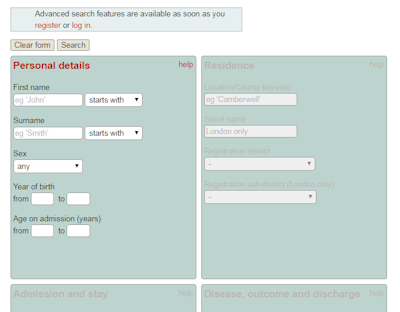
After registering, it is possible to use the advanced search facilities and download option. Advanced features allow users to search by residence, and includes an option to search for keyword or street name and/or selecting for registration district or sub-district among patients admitted from London. Registered users may also search for patient details using the admission or hospital stay details, this includes a drop-down menu for the institution where they were admitted and the doctor who admitted them. Additionally, users may search by both date of admission and release, and/or the length of stay in days. It is also possible to select to only view medical records where case notes are available, of which there are 5903 admission records available. Finally, it is possible to search based on disease, outcome and discharge details. This includes a text box search for disease name and ISD10 (International Statistical Classification of Diseases and Related Health Problems) as well as dropdown option for disease group, outcome, where they were discharged to, and the date of discharge which is repeated from the end of admission date. Once the search parameters are selected, up to 200 results are produced. The search matches can also be sorted by admission date, age, disease, first name, last name, registration district, sex and year of birth. Search results can be viewed online as 20 records a page or may be downloaded. Downloads however, are restricted to 200 cases per search, and as such larger searches can be time-consuming, although it is stated that users may contact Kingston University if they require larger downloads. These facilities allow for a detailed search of over 140,000 patient records, and are most useful in very specific searches, ideally those with less than 200 results. If search results are over 200 than it is still possible to access these, by checking the admission date for the 200th record produced, and conducting a second search starting from this date. However, this is not ideal, and even when searching for specific parameters, such as diagnoses, hospital or patient age with the large number of records available, returned results quite frequently exceed 200 cases.

A preliminary analysis of the HHARP database was conducted, in order to demonstrate the value of such a resource in further research. The first phase of this was to compare the patients admitted among the different hospitals in London and Glasgow, the second phase involved the analysis of the recorded disease groups of patients admitted to GOSH over time. While the HHARP admission records provide extensive options for analysis, for the purposes of this preliminary review only patient sex, age, county registered, and disease group will be discussed further. Results from this analysis determined that the number of patients admitted to each hospital increased significantly over time, and that this increase was correlated with hospital expansion, as the number of working clinicians and patient beds increased. Hospital growth therefore needs to be considered when analysing changes over time in the hospital records.
GLA, EH and GOSH had a significantly higher proportion of male patients admitted, compared to females, with no significant differences in the CH records, as illustrated in Figure 4a. The higher proportion of males admitted to hospital may indicate that parents were more likely to seek medical care for male children; historical literature has suggested that male children may have be given preferential access to resources including nutrition and medical care (Davin 1982; McKee 1984; Cozzi 2010; Horrell and Oxley 1999). However, the School Medical Officers Annual Report 1909-1910 found that of children with deficient nutrition, 53.8% were male (CI 4.09) (Story 1912). Interestingly, over time sex differences at GOSH and GLA increased, with a significantly higher percentage of males admitted to GOSH after 1894 and GLA after 1893. This suggests that the factors which resulted in greater percentage of male patients admitted, changed over time.
Mean patient age also varied significantly between hospitals as illustrated in Figure 4d, with CH and GLA having the highest mean patient age. However, among EH and GLA patient age was infrequently recorded and as such only in GOSH and CH could age be analysed further. At GOSH and CH mean patient age decreased significantly over time. These findings are consistent with historical reports of changes in hospital regulations (Lomax 1996. In order to avoid complications with infectious disease in hospital wards, early children’s hospital regulations were to refuse admittance children under two years of age. However findings for this review reveal that even in the early years of GOSH, patients under two years of age were frequently admitted (see Figure 4c), indicating that hospital protocols were not always adhered to. This is supported by historical literature which suggests that doctors frequently disregarded these regulations and children under two years of age were still admitted in urgent cases (Lomax 1996; Spence 1947).
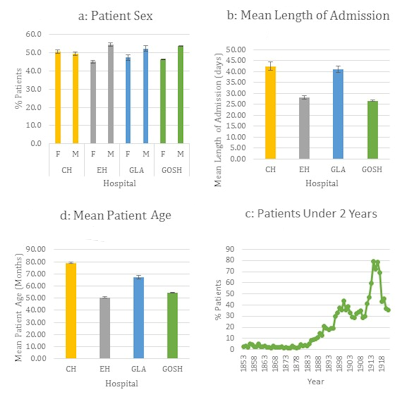
Over 7000 different diseases and disease combinations were recorded in the HHARP database providing extensive research opportunities. For the purpose of this review only disease groups will be discussed, as this provides a simple overview which indicates areas for further research. The relative percentage of each disease group was similar among all hospitals, although some significant differences were present. Records at GOSH were the most complete, and as such were analysed further to investigate how the proportion of different disease groups changed over time among children admitted. Over time at GOSH several significant differences were noted in the percentage of patients admitted among each disease group. Four such cases are illustrated in Figure 5. Further research is required to compare changes in admitted disease group as well as specific diagnoses over time, and to compare this with the historical literature and palaeopathological record. Changes in the percentage of disease groups over time may be related to economic, dietary, environmental, socio-cultural differences or changes in hospital policy and care; such as the policy to not admit children with fever or measles in the hospitals’ early years (Hardy 1992).
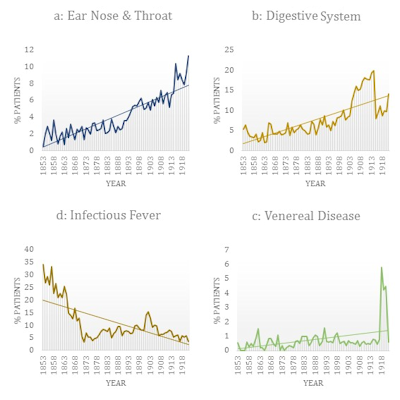
Patient recorded home county and district were also analysed for each of the London hospitals (the variation in geographical regions represented in the HHARP database are illustrated in Figure 6). As expected it was determined that the majority of patients were admitted from London. When considering the patients admitted outside of London, the greatest number were admitted from the same three counties (Kent, Surrey and Essex). There was considerable variation in the area patients were admitted from; EH had the smallest catchment area, with patients only being admitted from the counties surrounding London. GOSH had the largest catchment area, with patients being admitted from as far afield as Lincoln in the North and Cornwall in the West. Among patients admitted within London GOSH and CH showed a similar distribution, while patients at EH mostly lived in south of the Thames.
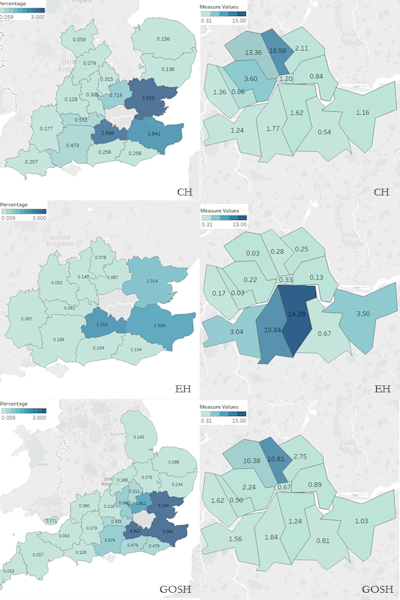
The HHARP website includes additional material, that may be pertinent for those who wish to conduct further research that is related to the admission records, including medical terminology, medical history, life in London, genealogy/family history. Additionally, there are downloadable PowerPoints providing a short comparison between the hospitals and an introduction to paediatric medicine prior to the development of children’s hospitals. Some of these links however, are no longer active, which indicate the how long ago this section was last updated. There is also a help section which provides useful hints and tips when conducting searches, such as which district each sub-district is located in, as well as providing a useful map illustrating the London registration districts. Finally,the news tab provides details of updates as well as volunteer opportunities, however there is no date stamp and so it is not possible to know when these updates occurred, or if the volunteer options are still available.
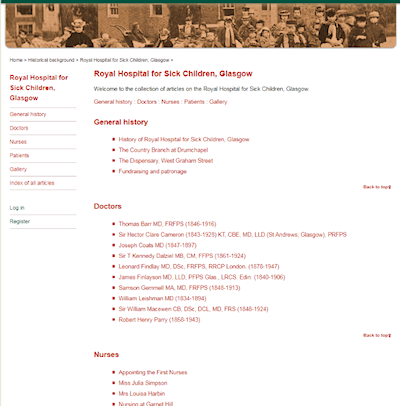
The main pages of the HHARP website are easily navigable, and provide a detailed historical background for the hospitals in the database. However there is a large portion of content which is only accessible by navigating through a series of other pages using site links, which can be quite tedious, and very likely results in valuable content going unnoticed and unused. In some cases, pages only consist of lists of site links, with no other text. For instance, within the Historical background section, there is a general articles page but it contains just has two site links for 'how to fund a hospital' and 'glossary of medical terms' both of which, would strongly benefit from a description of contents and a discussion of when this information may be of value. Similar issues were found within specific hospital pages, where a whole page would consist solely of site links rather than including any descriptive text, as illustrated in Figure 7. Links are under-utilised within other pages as a means of creating alternate navigating routes around the site. For instance, within the 'About the project' page there is a section on the addresses used in the database where more links to relevant section within the help pages would have been helpful. Additionally, within the background section, specific patients are discussed, such as with the Smith and Sallis Family while their admission records are discussed on this page, there is no link available to the indivudual records which could have been made in order to link the narrative directly with the underlying data. A more detailed navigation bar, with drop-down menus better demonstrating the subsections available would have been valuable.
This review has outlined the value of historical hospital records in palaeopathological research as well as the data available in the HHARP database. The value of medical archives resources is clear and the continued digitisation of hospital records provide a globally accessible resource for palaeopathological research. The variation in the hospitals included in the HHARP database further increases the potential value of comparative analysis, and while preliminary analysis had shown some similarities between them, differences in the proportion of male and female patients, mean age, length of stay and outcome were all present. Since significant changes were occurring in lifestyle, diet and environment particularly in cities which may influence health (Brimblecombe 1987; Kirk 1998; Ross 2007), the HHARP database may provide researchers with a greater insight regarding how children were impacted by industrialisation and urbanisation during this period.
Andersen R.M. 1995 'Revisiting the Behavioural Model and Access to Medical Care: Does It Matter?', Journal of Health and Social Behaviour 36, 1-10. https://doi.org/10.2307/2137284
Berkanovic E., Telesky C. and Reeder S. 1981 'Structural and Social Psychological Factors in the Decision to Seek Medical Care for Symptoms', Medical Care 1981(19), 693-709. https://doi.org/10.1097/00005650-198107000-00001
Brickley M. 2002 'An Investigation of Historical and Archaeological Evidence for Age-related Bone Loss and Osteoporosis', International Journal of Osteoarchaeology 12, 364-371. https://doi.org/10.1002/oa.635
Brimblecombe P. 1987 The Big Smoke: A History of Air Pollution in London Since Medieval Times, Abingdon: Routledge Taylor and Francis Group.
Cozzi, A. 2010 The Discourses of Food in Nineteenth-century British Fiction, Basingstoke: Palgrave Macmillan. https://doi.org/10.1057/9780230117525
Dastugue J. 1980 'Possibilities, limits and prospects in Paleopathology of the human skeleton', Journal of Human Evolution 9(1), 3-8. https://doi.org/10.1016/0047-2484(80)90035-4
Davin, A. 1982 'Child Labour, the Working-Class Family, and Domestic Ideology in 19th Century Britain', Development and Change 13(4), 633-652. https://doi.org/10.1111/j.1467-7660.1982.tb00141.x
Ginsburg K., Menapace A. and Slap G. 1997 'Factors Affecting the Decision to Seek Health Care: The Voice of Adolescents', Pediatrics 100(6). https://doi.org/10.1542/peds.100.6.922
Grauer A.L. 2016 A Companion to Paleopathology, Chichester: John Wiley and Sons, Ltd.
Hardy A. 1992 'Rickets and the Rest: Child-care, Diet and the Infectious Children's Diseases, 1850-1914', Social History of Medicine 5(3), 389-412. https://doi.org/10.1093/shm/5.3.389
HHARP the Historic Hospital Admission Records Project Kingston University. http://www.hharp.org
Horrell, S. and Oxley, D. 1999 'Crust or crumb? Intrahousehold resource allocation and male breadwinner family: the case of nineteenth century Britain', International Review of Social History 52, 494-522.
Kilgore K., Lee M., Leavitt J., Mokri B., Hodge D., Frank R. and Chen J. 2017 'Re-evaluating the Incidence of Idiopathic Intracranial Hypertension in an Era of Increasing Obesity', Ophthalmology 124(5), 697-700. https://doi.org/10.1016/j.ophtha.2017.01.006
Kirk N. 1998 Change, Continuity and Class: Labour in British Society, 1850-1920, Manchester: Manchester University Press.
Lomax E.M. 1996 'Small and special: the development of hospitals for children in Victorian Britain', Medical History 16, 1-217.
Magalhães, B. Lopes, C. and Santos, A. 2017 'Differentiating between rhinosinusitis and mastoiditis surgery from postmortem medical training: A study of two identified skulls and hospital records from early 20th century Coimbra, Portugal', International Journal of Paleopathology 17, 10-17. https://doi.org/10.1016/j.ijpp.2017.03.002
Mant M. and Holland A. 2016 Beyond the Bones: Engaging with Disparate Datasets, London: Academic Press.
McKee, L. 1984 'Sex differentials in survivorship and the customary treatment of infants and children', Medical Anthropology 8(2), 91-108. https://doi.org/10.1080/01459740.1984.9965894
Melton L.J., Palumbo P.J., Dwyer M.S. and Chu C. 1983. 'Impact of recent changes in diagnostic criteria on the apparent natural history of diabetes mellitus', American Journal of Epidemiology 117(5), 559-565. https://doi.org/10.1093/oxfordjournals.aje.a113578
Mitchell P. 2011 'Retrospective diagnosis and the use of historical texts for investigating disease in the past', International Journal of Paleopathology 1(2), 81-88. https://doi.org/10.1016/j.ijpp.2011.04.002
Mitchell P.D. 2016 'Improving the use of historical written sources in paleopathology', International Journal of Paleopathology 19, 88-95. https://doi.org/10.1016/j.ijpp.2016.02.005
Rogler L. 1997 'Making Sense of Historical Changes in the Diagnostic and Statistical Manual of Mental Disorders: Five Propositions', Journal of Health and Social Behaviour 38(1), 9-20. https://doi.org/10.2307/2955358
Ross E. 2007 Slum Travelers: Ladies and London Poverty, 1860-1920, London: University of California Press.
Rushton K. 2016 'The Records of Stannington Children’s Sanatorium: Charting Half a Century of Tuberculosis Care', Social History of Medicine 29(4), 829-839. https://doi.org/10.1093/shm/hkw027
Santos, A. 2015 'Archives and skeletons: An interdisciplinary approach to the study of paleopathology of tuberculosis', Tuberculosis 95(1), S109-S111. https://doi.org/10.1016/j.tube.2015.02.014
Spence J.C. 1947 'Care of Children in hospital', British Medical Journal 1(4490), 125-130. https://doi.org/10.1136/bmj.1.4490.125
Story J.B. 1912 'Medical inspection of schools and school children', Journal of The Statistical and Social Inquiry Society of Ireland XII(XCII), 523-545. https://doi.org/10.1007/BF02972281
Van der Merwe A.E. and Steyn M. 2010 'Adult scurvy in skeletal remains of late 19th century mineworkers in Kimberley, South Africa', International Journal of Osteoarchaeology 20, 207-316.
Waldron T. 2008 Paleopathology, Cambridge: Cambridge University Press. https://doi.org/10.1017/CBO9780511812569
Wood J., Milner G., Harpending H. and Weiss K. 1992 'The Osteological Paradox: Problems of Inferring Prehistoric Health from Skeletal Samples', Current Anthropology 33(4). https://doi.org/10.1086/204084
Internet Archaeology content is preserved for the long term with the Archaeology Data Service. Help sustain and support open access publication by donating to our Open Access Archaeology Fund.
Internet Archaeology is an open access journal based in the Department of Archaeology, University of York. Except where otherwise noted, content from this work may be used under the terms of the Creative Commons Attribution 3.0 (CC BY) Unported licence, which permits unrestricted use, distribution, and reproduction in any medium, provided that attribution to the author(s), the title of the work, the Internet Archaeology journal and the relevant URL/DOI are given.
Terms and Conditions | Legal Statements | Privacy Policy | Cookies Policy | Citing Internet Archaeology
Internet Archaeology content is preserved for the long term with the Archaeology Data Service. Help sustain and support open access publication by donating to our Open Access Archaeology Fund.